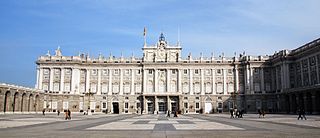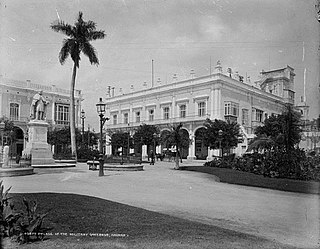
Lima is the capital and largest city of Peru. It is located in the valleys of the Chillón, Rímac and Lurín Rivers, in the desert zone of the central coastal part of the country, overlooking the Pacific Ocean. The city is considered the political, cultural, financial and commercial center of Peru. Due to its geostrategic importance, the Globalization and World Cities Research Network has categorized it as a "beta" tier city. Jurisdictionally, the metropolis extends mainly within the province of Lima and in a smaller portion, to the west, within the Constitutional Province of Callao, where the seaport and the Jorge Chávez Airport are located. Both provinces have regional autonomy since 2002.

Jorge Mario Pedro Vargas Llosa, 1st Marquess of Vargas Llosa, more commonly known as Mario Vargas Llosa, is a Peruvian novelist, journalist, essayist and former politician. Vargas Llosa is one of Latin America's most significant novelists and essayists and one of the leading writers of his generation. Some critics consider him to have had a larger international impact and worldwide audience than any other writer of the Latin American Boom. In 2010, he won the Nobel Prize in Literature, "for his cartography of structures of power and his trenchant images of the individual's resistance, revolt, and defeat." He also won the 1967 Rómulo Gallegos Prize, the 1986 Prince of Asturias Award, the 1994 Miguel de Cervantes Prize, the 1995 Jerusalem Prize, the 2012 Carlos Fuentes International Prize, and the 2018 Pablo Neruda Order of Artistic and Cultural Merit. In 2021, he was elected to the Académie française.

The Spanish Colonial Revival style is an architectural stylistic movement arising in the early 20th century based on the Spanish colonial architecture of the Spanish colonization of the Americas.

The monumental complex of the Basilica and Convent of San Francisco of Lima, also known as "San Francisco el Grande" or "San Francisco de Jesús", is located in the Historic Center of Lima, Peru. This church together with the Sanctuary Nuestra Señora de la Soledad and the Church del Milagro set up one of the welcoming and artistic corners of Lima. Ramón Menéndez Pidal, Spanish philologist and scholar in this regard commented: "It is the largest and noblest monument that the conquest erected in these prodigious lands".

The Casa de Osambela is a building built during the colonial era of Peru. It stands on the old Novitiate of the Dominican fathers, destroyed by the earthquake of 1746, and part of the garden, facing the Calle de la Veracruz in the historic center of the city of Lima. It is one of the largest mansions in the center of Lima and is notable for its wide façade and excellent quality balconies.

The Palacio de Torre Tagle is a building built during the colonial era of Peru that currently serves as the main headquarters of the Ministry of Foreign Affairs of Peru. It is located in the Jirón Ucayali in the historic center of Lima, two blocks southeast of the Plaza Mayor de Lima.

The Government Palace, also known as the House of Pizarro, is the seat of the executive branch of the Peruvian government, and the official residence of the president of Peru. The palace is a stately government building, occupying the northern side of the Plaza Mayor in Peru's capital city, Lima. Set on the Rímac River, the palace occupies the site of a very large huaca that incorporated a shrine to Taulichusco, the last kuraka of Lima.

Goyeneche Palace or Casa Goyeneche is a 17th-century manorial house in the city of Arequipa, Peru. It attracts tourists interested in observing colonial architecture in Peru. Located on La Merced street, the house looks much the same as other manorial houses of those times. It has ample patios, arched ceilings, doors and windows in typical colonial baroque style as well as a balcony.

Located principally in the city centre or Cercado de Lima and Rímac areas, the Historic Centre of Lima is among the most important tourist destinations in Peru.

Spanish Baroque is a strand of Baroque architecture that evolved in Spain, its provinces, and former colonies.

Spanish architecture refers to architecture in any area of what is now Spain, and by Spanish architects worldwide. The term includes buildings which were constructed within the current borders of Spain prior to its existence as a nation, when the land was called Iberia, Hispania, or was divided between several Christian and Muslim kingdoms. Spanish architecture demonstrates great historical and geographical diversity, depending on the historical period. It developed along similar lines as other architectural styles around the Mediterranean and from Central and Northern Europe, although some Spanish constructions are unique.

Peruvian architecture is the architecture carried out during any time in what is now Peru, and by Peruvian architects worldwide. Its diversity and long history spans from ancient Peru, the Inca Empire, Colonial Peru to the present day.

La Casa de Fierro, located in the city of Iquitos in the jungle of Peru, in front of the major square between Próspero and Putumayo streets, is a large iron residence built during the rubber boom at the end of the nineteenth century. The house was bought by the Bolivian explorer and entrepreneur Antonio Vaca Diez.

The Archbishop's Palace of Lima, the capital of Peru, is the residence of the Archbishop of Lima, and the administrative headquarters of the Archdiocese of Lima. It is located on the Plaza Mayor of Lima, in the Historic Centre of Lima.

The Peruvian colonial architecture, developed in the Viceroyalty of Peru between the 16th and 19th centuries, was characterized by the importation and adaptation of European architectural styles to the Peruvian reality, yielding an original architecture.

The Basilica and Priory of Nuestra Señora de la Merced is a Roman Catholic church located in Lima, Peru. It was designed in the Baroque style known as Churrigueresque. The church was built under the supervision of Friar Miguel de Orenes in 1535. The Blessed Virgin Mary of Mercy, the patroness of the Peruvian Armed Forces, is venerated in the Basilica. The Mercedarians, who evangelized the region, helped to develop Lima by building many of the churches preserved today.
The Historic Centre of Trujillo is the main urban area and the most important center of development and unfolding in the Peruvian city of Trujillo located in La Libertad Region. The whole process of its original urban fabric is in elliptical shape surrounded by España Avenue that was built in the wake of the Wall of Trujillo. It houses the seat of city government and other important entities in the locality. In the center of this historic urban area is the Plaza de Armas of Trujillo that was the scene of the Spanish founded of the city in 1534 and the proclamation of the independence of Trujillo on December 29, 1820.

The Palacio del Segundo Cabo was built in the last decades of the 18th century, between 1770 and 1791, as part of the urban improvement project around the Plaza de Armas.

The Casa de Aliaga is a colonial-style building located in the historic centre of Lima, Peru. Its current owner is Gonzalo Jorge de Aliaga Ascenzo, VIII Count of San Juan de Lurigancho.

The Church and Convent of Our Lady of Peñafrancia, better known as St. Clare's Monastery, is a Catholic church, convent and monastery belonging to the Capuchin Poor Clares located in the neighbourhood of Barrios Altos, part of the historic centre of Lima, Peru.























